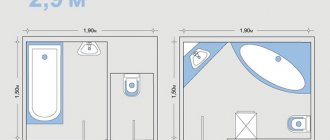In modern times, it is difficult to imagine an apartment or a private house without such an important element of plumbing as a toilet. Often it is necessary to carry out repair or maintenance work on the toilet. In order to perform this type of work competently, it is necessary to understand the structure and operating principle of such plumbing fixtures. This will be discussed in the article.
Toilet operating diagram
There are two options for making toilets:
- Hanging or wall-mounted , when the drain tank is suspended on the wall or is absent altogether.
- Floor-standing - toilets complete with a cistern, free-standing toilets, side-mounted ones (full contact with the wall), Turkish-type toilets or Genoa bowls (requires squatting during use).
Toilets consist of three main elements:
- Bowl;
- Cistern;
- Seat and cover (toilet).
Siphon operating principle
The operation of the siphon is based on the principle of changing atmospheric pressure and air pressure in the riser and sewer network. When the atmospheric pressure value is higher than the same air indicator in the sewer and riser, the volume of liquid in the water seal decreases, therefore, part of it enters the riser.
The opposite situation is also possible. Traditionally, the siphon entrance is made straight, and the exit can be either straight or inclined. It is worth remembering that when plumbing equipment is not used for a long time, the liquid from the water seal may evaporate completely or partially.
Toilet flush device: operating features
Types of toilets.
The drainage structure is activated by pressing a special button or pulling the rod. The latter is found only in inexpensive domestic toilets.
Related article: Types of extensions to a house
The most common drain mechanism is a push-button one. This water release device is a button equipped with a lever, which is located in the structure of the toilet cistern. The button can be placed either on the lid of the toilet tank or on the wall (in the case of a hidden tank design).
The toilet flusher, which is activated by pressing a special button, can be of single- and dual-mode types.
The second case involves draining absolutely all the water from the tank. The first type of device, in turn, removes only half of the tank, thereby saving water.
A two-mode water drainage complex can also be represented by one button, where the amount of water released directly depends on the force of pressure on the button.
Toilet flush complexes: classification
Scheme of connecting the toilet to the sewer.
There are 2 flushing systems in the toilet: circular (shower) and horizontal (cascade).
The horizontal flush is a classic system for supplying water to the toilet bowl. In this case, the water washes the bowl in a continuous stream, but only one side of it.
This system is less expensive, unlike a shower flush, and stands out among others due to its long service life. Among the disadvantages of horizontal flushing, it is worth highlighting the low percentage of tightness, since the water flow does not cover the entire capacity of the bowl. As a result, the toilet needs to be cleaned more frequently. Among other things, the horizontal type of flush wastes water uneconomically.
A circular flush implies a uniform supply of water around the entire perimeter of the toilet structure. Moreover, the water jets can be directed either at an angle to the toilet rim or straight.
This toilet flushing device differs from others in its minimal noise level, economical water consumption and excellent cleaning properties.
The downside of such toilets is their rather high cost compared to similar designs with a horizontal flush. In addition, the small diameter of the holes through which water is supplied increases the risk of deterioration in flush quality. This can happen due to the high degree of hardness of the water, which clogs these holes over time. Thus, if water of increased hardness is supplied to the apartment, you should choose either a large diameter of the holes in the toilet with a circular flush complex, or a horizontal flush type.
Flushing the toilet into the sewer
Installation and connection diagram for the drain tank.
Flushing the toilet directly depends on the location of the sewer pipe in the house.
Toilet production can be divided into 3 main types:
- Vertical.
- Oblique with an inclination of 30-45°.
- Horizontal release.
The latter can be found in houses with modern layouts (many houses from the post-perestroika period).
The sewer complex, equipped for toilets with vertical outlet, can mostly be found in apartments built in the first half of the twentieth century (Stalinist houses).
In houses built in the second half of the twentieth century (Brezhnevka and Khrushchevka), the sewer complex is designed specifically for the installation of toilets with an oblique type of outlet.
Before purchasing a toilet, you should definitely clarify which sewer pipe outlet is present in the house.
Toilets with oblique and horizontal outlets are more versatile designs, since they make it possible to connect the toilet to the sewer risers in any position. To do this, you need to purchase specialized adapters. The vertical flush type allows you to place the toilet flush against the wall.
Variations of toilet cisterns
Toilet installation sequence.
The current classification of flush tanks is much more diverse than it was 20 years ago. In order not to get lost in such a wide variety, it would not be amiss to become a little familiar with similar plumbing fixtures and its variations.
Related article: Curtains for car washes and car service stations
According to the type of materials used, tanks can be:
- metal (usually cast iron) - durable, but the external design is not highly aesthetic;
- plastic (plastic) - the lightest among all others, very easy to install, but susceptible to mechanical damage;
- ceramic ones are safe, easy to install, and have a huge range of different colors and shapes.
By type of release mechanism:
Toilet installation diagram: correct and incorrect.
- Side - they represent a chain (rope) equipped on the tank, which, in turn, is located at a small height from the toilet; The principle of operation of the drainage device in this case is as follows: the rope pulls the lever, and on the reverse arm the box with the gasket is raised slightly, and the water passes into the drainage pipe.
- Upper - head or button located on top of the lid in the central part; here water flows into the drain pipe only after pressing the necessary button or lifting the rod (rod); at the moment of pressing, the rubber bulb rises from the so-called saddle and lets the water flow through.
By type of release device:
- mechanical - everything is controlled without user participation;
- manual - the barrel valve opens at the owner’s request; at the same time, it is possible to control the volume of liquid that enters the tank.
Next, we can distinguish the types of waste cisterns according to the variations in their installation:
- The tank can be located almost under the flow, connecting to the toilet through a long fitting. This option allows you to achieve maximum water pressure during the descent process, but outwardly it does not look very aesthetically pleasing given the current realities of design.
- The tank is attached directly to the toilet. The option is quite compact, suitable for a variety of repair work.
- The drainage container is built into the wall structure. This method makes it possible to free up additional space in the toilet room, and it looks very diligent and quite aesthetically pleasing. A significant disadvantage, however, is the complexity of installation and further repair work.
Tank drain device
We propose to consider the design of a cistern using the example of a plastic model with a side water supply.
For such designs, the main elements of the tank will be:
Tank drain device
- Float type valve
- Pear combined with overflow
- Traction
- Float
- The bulb is made of rubber, the float is usually made of plastic, and the rod is made of non-corrosive metals (copper or brass). When the water is drained, the bulb will float up; after all the water has been drained, the rubber element returns to its place, thereby blocking the drain hole.
- An overflow is a cylinder with a neck. It is necessary to flush excess water into the toilet bowl if the float valve is faulty. Moreover, it can be either a separate structural element or combined with a rubber bulb.
- In old houses, a toilet was often installed with a highly suspended cistern, almost right under the ceiling. To ensure the drainage of water from such a tank, a siphon mechanism is used, which has a significant drawback in the form of noisy operation.
- The tank is connected to the water supply pipes through a reinforced rubber hose, which is secured with metal or brass nuts with O-rings.
- Cheaper, but less reliable, is the connection option using a plastic hose and plastic nuts.
- The pipe that connects the tank to the cold water pipeline can be located on the side of the tank (side water supply) or at the bottom (bottom water supply). It is worth noting that with a lower water supply the noise level is much lower. In addition, the second option is preferable from an aesthetic point of view.
Compact toilets have one hole on each side. During installation, one of them is used to connect the water supply, and the second is closed with a special plastic plug, which is secured with a latch or union nut. If necessary, it is easy to swap the plug and the float-type valve.
Important! The most critical and difficult moment in the design of the flush tank is the float-type valve in combination with the float itself.
There are two options for this design:
- Adjustable
- Non-adjustable valves.
Regardless of the type of this element, the valve must flawlessly perform its function - automatically stop the supply of water to the tank when the barrier level is reached.
Today, dual-mode flush mechanisms are widely used, which allow you to regulate the volume of water drained into the toilet bowl. In order to remove the cistern lid of a toilet with such a mechanism, you first need to unscrew the flush button itself.
Float type valve design
- Pressure washer
- Pad
- Saddle
- Membrane
- Kernel
- Float lever
- Lever axis
Types of toilets with a tank depending on location
An unremarkable plumbing product in the form of a toilet cistern is presented in a wide variety of species.
The toilet tank may have a solid body. This monoblock is easy to install. It is enough to install the structure of the flush cistern with the toilet bowl and connect the pipes for supplying and draining water. The product can be floor-standing or hanging. If one of the components of the tank fails, it must be completely replaced, which will lead to disharmony in the design of the monoblock.
The traditional option is represented by a separate toilet cistern, which makes it possible to combine different models of the components of a single system. If you purchase a toilet cistern separately, there are three options for installing the structure. The tank can be attached to the wall, built into it or located on the toilet.
The traditional option is represented by a separate toilet cistern, which makes it possible to combine different models of components of a single system
A wall-hung toilet cistern involves both high and low placement of the element. In the first case, the tank is located at a certain height and is connected to the toilet using a long pipe. This old-fashioned placement is characterized by the creation of optimal pressure and high water flushing speed. However, there is a high level of noise during drainage. The flushing device of the old-style cistern is represented by a lever with a chain located on the side.
Low placement of the cistern is very popular. The element is attached to the wall and connected to the toilet using a short tube. Water is drained from the tank by pressing a button on the device body.
How to choose a toilet: main criteria and features of various models
Review of the 5 most popular manufacturers and models. Common breakdowns and ways to fix them.
The compact version is a design where the tank is located on the toilet. Despite the fact that it is similar in appearance to a candy bar, such a tandem consists of two separate elements. There is a special shelf on the toilet on which the tank is installed and then securely fixed to it. The advantages of the design are compact size and ease of maintenance.
Quite common is the corner toilet cistern, which has a triangular or trapezoidal shape, making the structure convenient to place in the corner of the room if it is small.
There is also a hanging version of the product with a flush cistern built into the wall.
The built-in toilet cistern (in the wall) is hidden in a special closed niche. Only a button for draining water is exposed outside, through the hole in which preventive inspection and repair of the device is carried out. Choosing a hidden cistern for the toilet contributes to the aesthetic design of the bathroom interior. In this case, the toilet will be moved close to the wall, which will make the room more spacious and tidy. There is also a hanging version of the product with a cistern built into the wall.
Toilet cistern repair
Probably the most common problem associated with the operation of drain tanks is the appearance of leaks. Needless to say, this situation is undesirable, especially if the apartment has a water meter (a leak will lead to additional costs).
The main causes of leaks
Among the entire range of reasons that can cause a tank to leak, the most significant and common ones can be identified:
- Violation of the tightness of the bulb or gaskets (petals).
- Float adjustment is incorrect. In this case, the water will pass through the overflow level and flow out.
- When flushing water, there is a leak between the tank and the toilet platform itself.
- Violation of the tightness of the connection between the hose and the float valve.
- Loss of tightness in the threaded connection of the tank and toilet.
Troubleshooting Methods
To carry out repair work aimed at correcting any malfunction, the first step is to remove the top cover of the drain tank.
Violation of the tightness of the bulb or gaskets
Cistern bulb
In this case, there is a constant flow of water into the bowl. To eliminate the problem, you need to take out the pear and inspect it carefully.
With prolonged use, deformation of the bulb and gaskets or the formation of plaque on them is possible. You will need to wipe these elements and try to fit them tightly together. If the bulb and the gasket cannot be tightly connected, these elements must be replaced.
Float adjustment failure
Vertical Float Valve Standard Lever Valve
With this malfunction, water constantly flows through the overflow valve. There are a number of reasons for this violation:
- The float lever is not enough to close the float type valve. To solve the problem you need to bend the lever.
- The design of your float matches the picture on the left. Use a plastic pin to lower the float level. After this, the adjustment will be completed and the leak will disappear.
- Water got into the float. In this case, the float is removed, the water is drained from it and put back in place.
- The float cannot shut off the water because the gasket inside its valve has worn out. In this case, the structure is disassembled, the gasket is turned over to the other side or a new one is cut out.
If any of these reasons cannot be eliminated, then the float mechanism must be completely replaced with a new one.
The appearance of a leak between the tank and the toilet when flushing water
The cause of this malfunction may be:
- There is a looseness in the thread connected to the cistern and toilet. To solve the problem, it is necessary to tighten all the bolts and nuts, but without making much effort, so as not to destroy the platform between the tank and the toilet.
- Casting defects in plumbing fixtures. In this case, it is necessary to treat the leakage areas with sealant.
Loss of tightness between the hose and the float valve
Causes of malfunction:
- Loosening the nuts, to solve the problem you need to take a wrench and tighten the nuts.
- The connection gasket is damaged. It is necessary to unscrew the nut, replace the gasket and screw the hose nut back.
Loss of tightness in the threaded connection of the tank and toilet.
Most likely the reason is a weakening of the connection itself. To fix the problem, you need to tighten the bolts and nuts without putting much effort. If the leak is not eliminated, then these elements must be completely unscrewed, lubricated with gaskets (treated with sealant) and screwed back.
Helpful information ! Faults of this kind can be easily fixed on your own. This will bring you experience and new skills, and will also help you significantly save money on your family budget.
To illustrate the methods described in the article for troubleshooting the drain tank, we suggest watching the video.
What are the differences between toilet cisterns?
There are enough factors that make one piece of equipment different from another, the first being the material from which they are made:
| Metal | The service life of the equipment is long, but they do not have the most aesthetic appearance. |
| Plastic | Light weight, easy installation. The disadvantage is that they can be easily damaged. |
| Ceramics | Most Popular. Reliable and easy to install. Customers are now offered a variety of color variations and shapes. |
The second difference is the type of trigger, which can be side or top.
- The first can often be found in various institutions, as well as schools, public buildings, and universities . The trigger mechanism is a simple chain attached to the tank itself, located at a certain height from the toilet. Its operating principle is as follows: you need to pull the chain, which pulls the lever behind it, at the other end of which the plug with the gasket is lifted, after which water begins to flow into the drain pipe.
- The top type is a special head or button located at the top of the cistern lid . This type of trigger mechanism is currently the most popular. It works like this: after pressing the button, the rubber bulb rises, and water begins to flow into the drain pipe.
There are also differences in the type of trigger mechanism - it can be manual or mechanical. In the latter case, the instructions allow all adjustments to be made without user intervention. In the case of a manual type, the tank valve will open only according to its thirst, which allows you to regulate the amount of water used for flushing.
Other separation methods
In addition to the above, drainage tanks are also divided according to:
- installation option;
- flushing method.
Let's look at the installation:
- The container is placed almost under the ceiling and connected to a toilet with long fittings . The appearance of the installation in this case is far from aesthetic, but along with this, high water pressure appears.
- The second type of installation is that the container is mounted directly on the toilet . This method is considered the most preferable and does not incur enormous costs than the next one. The set turns out to be quite compact and has an attractive appearance; in addition, it is ergonomic when carrying out repair work.
- The third type is that the cistern is built directly into the wall . Due to this, it is possible to free up space in the toilet room and improve its appearance. The disadvantage is the complexity of installation and repair work.
Let's deal with the drain:
- Direct flush - in this case, water begins to flow into the toilet from the flush tank. There is no provision for changing the direction of its movement.
- Reverse flush - in this case, a change in the direction of water when flushing is provided. The advantage is the most functional method. Disadvantages - creates more noise for the same functionality.
How the cistern works
The shape, structure and color of the equipment may vary depending on the material of its manufacture. One thing remains unchanged - the device must collect and drain water. The process is ensured by the internal structure of the drain tank.
Much more often it has 2 main mechanisms - supplying and draining water, which in turn are divided into:
- float and its valve;
- pear;
- overflow;
- levers.
They can be made from different materials, be different in shape, have different methods of connecting to each other, but their essence of work and principle do not change.
Water supply
- The fittings are located on top, water enters the container through the side channel. On one side of the lever there is a float and, when the water in the tank reaches a certain level, the lever will otherwise press on the rod and block its supply through the membrane. The method is quite often used by domestic manufacturers. The disadvantage is a lot of noise throughout the tank set.
- Water supply from below the cistern . In this case, the toilet float moves directly along the vertical rod; energy is transferred to the membrane as it moves through traction. The latter regulates the movement of water in the tank. In this case, the noise is minimal or completely absent.
The second option is now used much more often. In this case, the drain tank is equipped with a push-button mechanism, often with two modes - 2-4 l and 6-8 l.
In public places it is possible to find automatic drainage systems. They are more hygienic because they do not require touching the elements of the mechanism.
They react to movement. The disadvantage is the high price of the devices.
Principle of operation
Let's take a closer look at how the device works:
- After pressing the button, the drainage system starts.
- Now the rod that lifts the pear is activated.
- The pear opens the shut-off valve of the drain mechanism, through which water begins to flow into the toilet and sewer system.
Advice: do not forget that the process is controlled by the control valves for draining water from the tank. Its design depends on the design used and may have its own distinctive features.
It goes without saying that the drain tank, like any other equipment, can break down during operation. It contains weak elements that can wear out.
Main troubles:
- incontinence of water in the container;
- slow filling of the tank;
- excessive amount.
Repair
Water incontinence
One of the main reasons is water overflow. You can fix the problem yourself by adjusting the overflow level. To do this, install the float so that the flow stops below the overflow.
Another circumstance is that the shut-off valve allows water to pass through.
There are two ways to solve the problem:
- Replace the old rubber membrane with a new one . In this case, there is no need to disconnect the flush tank from the toilet. Remove the upper part of the drain mechanism and carry out the necessary actions. The price of the membrane is low.
- Clean the valve of any debris that in most cases accumulates underneath it.
Water flows slowly
A common problem is that the overlying membrane is clogged. To solve the problem, you need to clear the hole for supplying water to the tank from debris. Prepare wire cutters or pliers for work.
Advice: carefully disassemble the membrane mechanism, it is better to take photographs or sketch the stages, so that during assembly you can put everything in its place.
Lots of water coming in
The solution to the problem is to adjust the water supply level, while also paying attention to the float. When feeding from the side, make adjustments by unscrewing the lever nut in order to reduce the water level with the float to the desired level.
If the supply is lower, set the float level using a plastic rod. Perform manipulations until it drops to the required level.
Other problems will need to be solved by replacing old parts with new ones.
Types of drain mechanisms
Today you can find two types of drainage devices on sale:
- In order for water to pass from the flush cistern directly into the toilet, a rod or a special button is placed on the lid, which will move the lever
Single-mode;
- Dual-mode.
In the first case, draining is carried out by emptying the entire tank; the second has two buttons in its design - they are responsible for pouring out a certain amount of water. This volume can be adjusted; in addition, the use of such systems is completely justified, since water is seriously saved here.
Although the type of drain mechanism may be different, it operates on the same principle. A little differently, the impulse of movement occurs to the valve, which either opens or closes the hole through which the water leaves.
The principle of its operation depends on how this valve is designed. Sometimes this valve is placed at the end of tubular drains that act as an overflow. In other cases, a similar structure opens and closes thanks to special chains made of metal or plastic. The last type of design is far from the most successful, since such a system often fails.
Depending on who the manufacturer of this device is, the design can have quite significant differences. However, all these systems can be divided into two key components:
- Water drainage system;
- Water collection system.
Due to the water collection system, the tank is filled. It can be either side or bottom. If the design has a bottom feed, then they are very convenient for several reasons. First of all, the main positive side is the almost silent operation, but the design of this system is very complex.
It includes the following elements:
- Vertical rod float;
- Traction;
- Buoy.
The water supply shutoff unit begins to operate due to the traction, which is connected to the buoy into one common structure, which at the same time represents a water level limiter.
If water is supplied from the side, then this design will be more reliable, but when filling the tank it will make quite a lot of noise. Here the operating principle of the entire system will be much simpler. The tank contains a special membrane, thanks to which water flows into and stops the tank, as well as a small float connected to the supply tap using a lever.
When the tank is filled, the float rises and the lever begins to move, gradually cutting off the water supply when the required volume of water is collected.
Drain water from the tank from above or from the side. The side design is used mainly for hanging tanks, which are almost never used today. Most modern products use a drainage system with an upper water drainage principle.
As a rule, the trigger structure is a bulb made of rubber or rubberized plastic. This equipment is not too expensive, but at the same time very reliable.
In order for water to pass from the flush cistern directly into the toilet, a rod or a special button is placed on the lid, which will move the lever. As mentioned earlier, modern systems for draining water in tanks can have one or two operating modes.
The second type has two buttons, which release either half of the tank or the full one. This option is most suitable for people for whom saving water is not just empty words.











